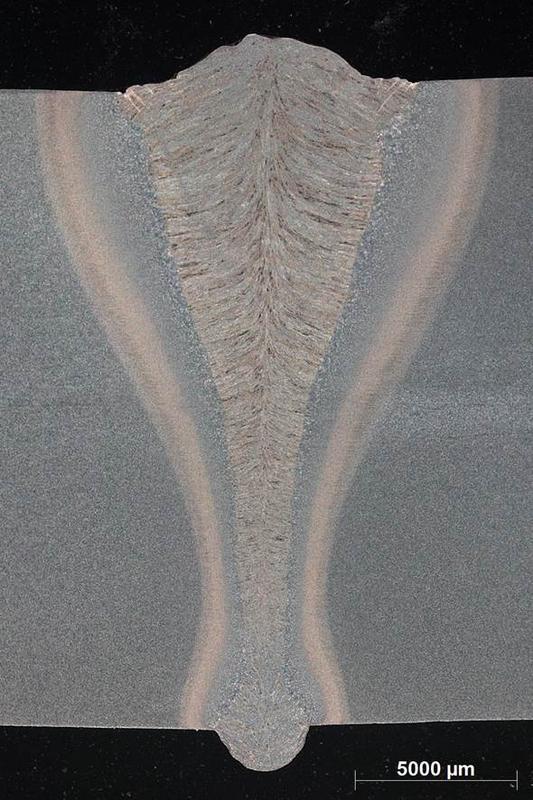Reliable joining of high-strength steels using a laser hybrid welding process

Single layer laser-GMA hybrid welding: Cross-section of a weld seam of 20 mm thick high-strength, fine-grain structural steel of the grade S690QL. Photo: LZH
However, for thicker high-strength, fine-grain structural steels, hot cracks and undesired hardness levels can occur in the welding seam. For this reason, in an interdisciplinary project scientists at the Laser Zentrum Hannover e.V. (LZH) and the Leibniz Universität Hannover (LUH) have developed a hybrid welding system with inductive preheating. This process can be used for reliable, high-quality, single-layer welding of high-strength, fine-grain structural steels up to a thickness of 20 mm.
In order to increase the weld seam quality for laser-GMA hybrid welding, the Joining and Cutting of Metals Group at the LZH has expanded the process to include integrated, inductive preheating. Directly before the welding process takes place, an induction coil brings energy into a targeted area of the welding seam.
Thus, the steel is preheated to the desired temperature, without direct contact. The weld seams are less brittle, fracture strain values are better, and hot cracks can be avoided. With this process, steel sheets can be welded with a single-layer, and time and material can be significantly saved.
Developed for Practical Application
The process was developed for high-strength, fine-grain structural steels with yield strengths from 460 to 690 N/mm². Applications for the used grades S700MC, X70 and S690QL can be found in crane, pump, pipeline and bridge construction, and in offshore areas. With this process, depending on the sheet thickness, feed rates of 0.75 m/min to 2.5 m/min can be reached.
Successful Interdisciplinary
The basis for the project was close cooperation between the material and process technicians from the LZH, and the engineers from the civil engineering and electrical engineering fields at the LUH. While the engineers at the LZH experimented with welding processes, the Institute for Electrotechnology and the Institute for Steel Construction (both LUH) made simulations of the preheating process, respectively the welding process, and evaluated the welding seams.
The project DOVOR – High-performance welding of high-strength, fine-grained steels with high process reliability, using a hybrid welding process with integrated preheating – was financially supported by the German Federation of Industrial Research Associations “Otto von Guericke” e.V. (AiF) and the Research Association for Steel Application (FOSTA).
http://www.lzh.de/en/publications/pressreleases/2014/reliable-joining-of-high-st… – further illustration and a video
Media Contact
More Information:
http://www.lzh.de/enAll latest news from the category: Process Engineering
This special field revolves around processes for modifying material properties (milling, cooling), composition (filtration, distillation) and type (oxidation, hydration).
Valuable information is available on a broad range of technologies including material separation, laser processes, measuring techniques and robot engineering in addition to testing methods and coating and materials analysis processes.
Newest articles

Properties of new materials for microchips
… can now be measured well. Reseachers of Delft University of Technology demonstrated measuring performance properties of ultrathin silicon membranes. Making ever smaller and more powerful chips requires new ultrathin…

Floating solar’s potential
… to support sustainable development by addressing climate, water, and energy goals holistically. A new study published this week in Nature Energy raises the potential for floating solar photovoltaics (FPV)…

Skyrmions move at record speeds
… a step towards the computing of the future. An international research team led by scientists from the CNRS1 has discovered that the magnetic nanobubbles2 known as skyrmions can be…





















